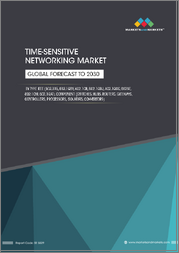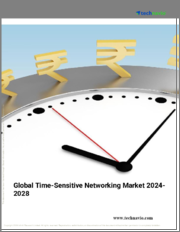
|
시장보고서
상품코드
1677997
세계의 TSN(Time-Sensitive Networking) 시장 규모, 점유율, 성장 분석, 유형별, 컴포넌트별, 최종사용자별, 지역별 - 산업 예측(2025-2032년)Time-Sensitive Networking Market Size, Share, and Growth Analysis, By Type (IEEE 802.1 AS, IEEE 802.1 Qbv), By Component (Switches, Hubs Routers and Gateways), By End User, By Region - Industry Forecast 2025-2032 |
||||||
TSN(Time-Sensitive Networking) 세계 시장 규모는 2023년 3억 5,600만 달러로 평가되었습니다. 또한, 2024년 5억 2,267만 달러에서 2032년에는 7억 9,425만 달러로 성장하고, 예측 기간(2025-2032년) 동안 2%의 연평균 복합 성장률(CAGR)을 보일 것으로 예측됩니다.
예측에 따르면, 다양한 산업에서 자동화에 대한 수요가 크게 증가하고 있으며, 장기적으로 시간에 민감한 네트워킹의 채택이 증가할 것으로 예상됩니다. 엣지 컴퓨팅과 5G 기술의 확장은 시간 민감형 네트워킹 제공업체들에게 새로운 성장 기회를 제공할 것입니다. 커넥티드카 및 스마트 시티 인프라의 저지연 네트워크에 대한 요구는 향후 몇 년동안 시간 민감형 네트워킹 구성 요소의 매출을 증가시킬 것으로 예상됩니다. 또한, 제조, 물류, 자동차 등의 분야에서 인더스트리 4.0이 추진됨에 따라 시간 민감형 네트워킹에 대한 수요는 더욱 증가할 것으로 보입니다. 그러나 레거시 시스템과의 통합, 숙련된 인력 부족, 일관성 없는 표준, 중요 용도의 보안 위험 등의 문제는 예측 기간 동안 시간 민감형 네트워킹의 채택을 방해할 수 있습니다.
목차
서론
- 조사 목적
- 조사 범위
- 정의
조사 방법
- 정보 조달
- 2차와 1차 데이터 방법
- 시장 규모 예측
- 시장 전제조건과 제한
주요 요약
- 세계 시장 전망
- 공급과 수요 동향 분석
- 부문별 기회 분석
시장 역학과 전망
- 시장 개요
- 시장 규모
- 시장 역학
- 성장 촉진요인과 기회
- 성장 억제요인과 과제
- Porter의 Five Forces 분석
주요 시장 인사이트
- 중요 성공 요인
- 경쟁 정도
- 주요 투자 기회
- 시장 생태계
- 시장의 매력 지수(2024년)
- PESTEL 분석
- 거시경제 지표
- 밸류체인 분석
- 가격 분석
TSN(Time-Sensitive Networking) 시장 규모 : 유형별
- 시장 개요
- IEEE 802.1 AS
- IEEE 802.1 Qbv
- IEEE 802.1 CB
- IEEE 802.1 Qbu
- IEEE 802.1 Qcc
- 기타
TSN(Time-Sensitive Networking) 시장 규모 : 컴포넌트별
- 시장 개요
- 스위치
- 허브 라우터 및 게이트웨이
- 컨트롤러 및 프로세서
- 아이솔레이터 및 컨버터
TSN(Time-Sensitive Networking) 시장 규모 : 최종사용자별
- 시장 개요
- 전력 및 에너지
- 자동차
- 운송
- 석유 및 가스
- 통신 및 데이터센터
- 제약
- 항공우주
- 기타
TSN(Time-Sensitive Networking) 시장 규모
- 북미
- 미국
- 캐나다
- 유럽
- 독일
- 스페인
- 프랑스
- 영국
- 이탈리아
- 기타 유럽
- 아시아태평양
- 중국
- 인도
- 일본
- 한국
- 기타 아시아태평양
- 라틴아메리카
- 브라질
- 기타 라틴아메리카
- 중동 및 아프리카
- GCC 국가
- 남아프리카공화국
- 기타 중동 및 아프리카
경쟁 정보
- 주요 5개사 비교
- 주요 기업의 시장 포지셔닝(2024년)
- 주요 시장 기업이 채택한 전략
- 최근 시장 동향
- 기업의 시장 점유율 분석(2024년)
- 주요 기업 개요
- 기업 상세
- 제품 포트폴리오 분석
- 기업 부문별 점유율 분석
- 매출 전년대비 비교(2022-2024년)
주요 기업 개요
- Cisco Systems(United States)
- Intel Corporation(United States)
- Broadcom Inc.(United States)
- Marvell Technology Group(United States)
- Analog Devices(United States)
- Texas Instruments(United States)
- Microchip Technology(United States)
- Belden Inc.(United States)
- Rockwell Automation(United States)
- Schneider Electric(France)
- Siemens AG(Germany)
- Honeywell International(United States)
- ABB Ltd.(Switzerland)
- Eaton Corporation(Ireland)
- Ciena Corporation(United States)
- Arista Networks(United States)
- Extreme Networks(United States)
결론과 제안
LSH 25.04.23Global Time-Sensitive Networking Market size was valued at USD 356.0 million in 2023 and is poised to grow from USD 502.67 million in 2024 to USD 7942.59 million by 2032, growing at a CAGR of 41.2% during the forecast period (2025-2032).
Forecasts indicate a significant increase in demand for automation across various industries, which is expected to enhance the adoption of time-sensitive networking (TSN) over the long term. The expansion of edge computing and 5G technologies presents new growth opportunities for TSN providers globally. The need for low-latency networks in connected vehicles and smart city infrastructures will likely drive sales of TSN components in the coming years. Additionally, the push for Industry 4.0 in sectors such as manufacturing, logistics, and automotive will further boost TSN demand. However, challenges like integration with legacy systems, a lack of skilled workers, inconsistent standards, and security risks in critical applications may hinder TSN adoption throughout the forecast period.
Top-down and bottom-up approaches were used to estimate and validate the size of the Global Time-Sensitive Networking market and to estimate the size of various other dependent submarkets. The research methodology used to estimate the market size includes the following details: The key players in the market were identified through secondary research, and their market shares in the respective regions were determined through primary and secondary research. This entire procedure includes the study of the annual and financial reports of the top market players and extensive interviews for key insights from industry leaders such as CEOs, VPs, directors, and marketing executives. All percentage shares split, and breakdowns were determined using secondary sources and verified through Primary sources. All possible parameters that affect the markets covered in this research study have been accounted for, viewed in extensive detail, verified through primary research, and analyzed to get the final quantitative and qualitative data.
Global Time-Sensitive Networking Market Segments Analysis
Global Time-Sensitive Networking Market is segmented by Type, Component, End User and region. Based on Type, the market is segmented into IEEE 802.1 AS, IEEE 802.1 Qbv, IEEE 802.1 CB, IEEE 802.1 Qbu, IEEE 802.1 Qcc and Others. Based on Component, the market is segmented into Switches, Hubs Routers and Gateways, Controllers and Processors and Isolators and Converters. Based on End User, the market is segmented into Power and Energy, Automotive, Transportation, Oil & Gas, Telecom and Data Centre, Pharmaceutical, Aerospace and Others. Based on region, the market is segmented into North America, Europe, Asia Pacific, Latin America and Middle East & Africa.
Driver of the Global Time-Sensitive Networking Market
The global Time-Sensitive Networking (TSN) market is experiencing significant growth, primarily driven by the increasing digital transformation across various industry sectors. This shift has spurred a higher demand for automation, as TSN facilitates precise synchronization and reliable data transfer, which are crucial for the effective operation of industrial robots and automated guided vehicles (AGVs). Additionally, the rising adoption of the Industry 4.0 paradigm and the development of smart factories further contribute to the positive market outlook. As industries embrace these advancements, the need for efficient and dependable networking solutions continues to escalate, propelling the TSN market forward.
Restraints in the Global Time-Sensitive Networking Market
Despite the increasing adoption of time-sensitive networking (TSN), the market faces significant challenges due to the lack of cohesive standards and regulatory frameworks. This absence of unified guidelines is likely to hinder the sector's growth, preventing it from attaining its maximum potential. Particularly in industries such as automotive, industrial automation, and telecommunications, the disparity in standards could pose substantial obstacles, complicating the deployment processes and slowing down widespread acceptance. Consequently, these limitations may restrict the overall advancement and integration of time-sensitive networking technologies across various applications, ultimately impacting the market's expansion and innovation trajectory.
Market Trends of the Global Time-Sensitive Networking Market
The Global Time-Sensitive Networking (TSN) market is witnessing a notable trend towards the integration of IT (Information Technology) and OT (Operational Technology) networks. This convergence is essential for enabling reliable, real-time communication across diverse sectors, including industrial automation, enterprise systems, and cloud platforms. As industries increasingly prioritize data-driven decision-making and embrace digital transformation, the demand for TSN solutions is expected to surge. Companies are anticipated to capitalize on this trend, leveraging TSN's capabilities to enhance operational efficiency and reliability, with growth projections extending through 2032, highlighting the transformative potential of this technology in various applications.
Table of Contents
Introduction
- Objectives of the Study
- Scope of the Report
- Definitions
Research Methodology
- Information Procurement
- Secondary & Primary Data Methods
- Market Size Estimation
- Market Assumptions & Limitations
Executive Summary
- Global Market Outlook
- Supply & Demand Trend Analysis
- Segmental Opportunity Analysis
Market Dynamics & Outlook
- Market Overview
- Market Size
- Market Dynamics
- Drivers & Opportunities
- Restraints & Challenges
- Porters Analysis
- Competitive rivalry
- Threat of substitute
- Bargaining power of buyers
- Threat of new entrants
- Bargaining power of suppliers
Key Market Insights
- Key Success Factors
- Degree of Competition
- Top Investment Pockets
- Market Ecosystem
- Market Attractiveness Index, 2024
- PESTEL Analysis
- Macro-Economic Indicators
- Value Chain Analysis
- Pricing Analysis
Global Time-Sensitive Networking Market Size by Type & CAGR (2025-2032)
- Market Overview
- IEEE 802.1 AS
- IEEE 802.1 Qbv
- IEEE 802.1 CB
- IEEE 802.1 Qbu
- IEEE 802.1 Qcc
- Others
Global Time-Sensitive Networking Market Size by Component & CAGR (2025-2032)
- Market Overview
- Switches
- Hubs Routers and Gateways
- Controllers and Processors
- Isolators and Converters
Global Time-Sensitive Networking Market Size by End User & CAGR (2025-2032)
- Market Overview
- Power and Energy
- Automotive
- Transportation
- Oil & Gas
- Telecom and Data Centre
- Pharmaceutical
- Aerospace
- Others
Global Time-Sensitive Networking Market Size & CAGR (2025-2032)
- North America (Type, Component, End User)
- US
- Canada
- Europe (Type, Component, End User)
- Germany
- Spain
- France
- UK
- Italy
- Rest of Europe
- Asia Pacific (Type, Component, End User)
- China
- India
- Japan
- South Korea
- Rest of Asia-Pacific
- Latin America (Type, Component, End User)
- Brazil
- Rest of Latin America
- Middle East & Africa (Type, Component, End User)
- GCC Countries
- South Africa
- Rest of Middle East & Africa
Competitive Intelligence
- Top 5 Player Comparison
- Market Positioning of Key Players, 2024
- Strategies Adopted by Key Market Players
- Recent Developments in the Market
- Company Market Share Analysis, 2024
- Company Profiles of All Key Players
- Company Details
- Product Portfolio Analysis
- Company's Segmental Share Analysis
- Revenue Y-O-Y Comparison (2022-2024)
Key Company Profiles
- Cisco Systems (United States)
- Company Overview
- Business Segment Overview
- Financial Updates
- Key Developments
- Intel Corporation (United States)
- Company Overview
- Business Segment Overview
- Financial Updates
- Key Developments
- Broadcom Inc. (United States)
- Company Overview
- Business Segment Overview
- Financial Updates
- Key Developments
- Marvell Technology Group (United States)
- Company Overview
- Business Segment Overview
- Financial Updates
- Key Developments
- Analog Devices (United States)
- Company Overview
- Business Segment Overview
- Financial Updates
- Key Developments
- Texas Instruments (United States)
- Company Overview
- Business Segment Overview
- Financial Updates
- Key Developments
- Microchip Technology (United States)
- Company Overview
- Business Segment Overview
- Financial Updates
- Key Developments
- Belden Inc. (United States)
- Company Overview
- Business Segment Overview
- Financial Updates
- Key Developments
- Rockwell Automation (United States)
- Company Overview
- Business Segment Overview
- Financial Updates
- Key Developments
- Schneider Electric (France)
- Company Overview
- Business Segment Overview
- Financial Updates
- Key Developments
- Siemens AG (Germany)
- Company Overview
- Business Segment Overview
- Financial Updates
- Key Developments
- Honeywell International (United States)
- Company Overview
- Business Segment Overview
- Financial Updates
- Key Developments
- ABB Ltd. (Switzerland)
- Company Overview
- Business Segment Overview
- Financial Updates
- Key Developments
- Eaton Corporation (Ireland)
- Company Overview
- Business Segment Overview
- Financial Updates
- Key Developments
- Ciena Corporation (United States)
- Company Overview
- Business Segment Overview
- Financial Updates
- Key Developments
- Arista Networks (United States)
- Company Overview
- Business Segment Overview
- Financial Updates
- Key Developments
- Extreme Networks (United States)
- Company Overview
- Business Segment Overview
- Financial Updates
- Key Developments

















